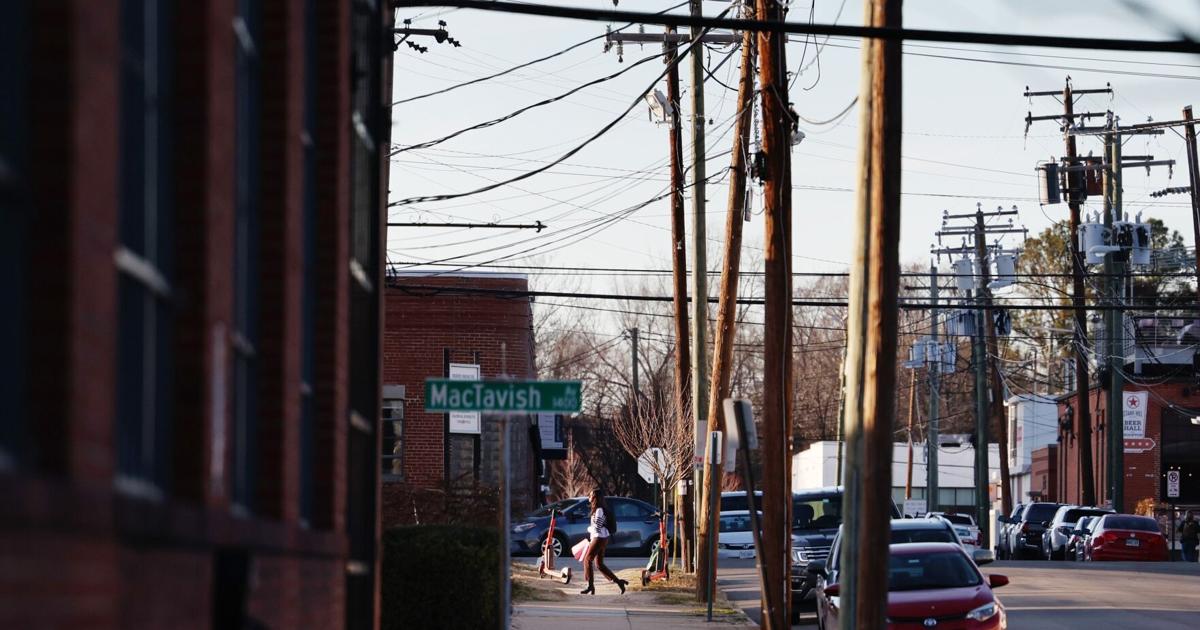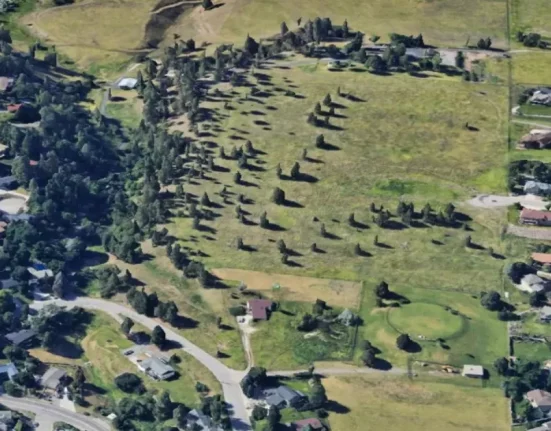Scott’s Addition has been an iconic example of what planners and architects like to call adaptive reuse of historic buildings – even though the roughly century-old commercial buildings that opened the door to tax-credit financed redevelopment 19 years ago are not everyone’s notion of landmarks.
But the Richmond neighborhood, just west of Arthur Ashe Boulevard and north of West Broad Street, has been changing.
Now, the scale of investment, like the size of the buildings, is increasing. And the feel of the place is different.
A person crosses the street in Scott’s Addition before sunset on Thursday.
Scott’s Addition is in what is really its fourth transformation from a portion of a 600-acre plantation that U.S. Army General Winfield Scott inherited from his father in law Col. John Mayo in 1818.
People are also reading…
It is becoming a neighborhood of luxury apartments and costly condos surrounded by restaurants, drinking spots and trendy business offices, in the heart of a city in the midst of an affordable housing crisis.
Rob Long, president of the Greater Scott’s Addition Association, is the owner of River City Roll.
“When I moved back to Richmond, it had everything I wanted, everything a young person would want,” said Rob Long, president of the Greater Scott’s Addition Association. He launched his business, River City Roll, a venue with a bowling alley, restaurant and bar on the edge of the historic district, in 2018, a few years after he moved to the neighborhood.
“Now there are lot more residents … I think they want what I did; it’s a cool place,” he said.
In the ‘first half’ of latest transformation
And the transformation is still underway.
“I’d say we’re in the second quarter, first half” in the historic district, Long said. “If you think of Greater Scott’s Addition, we’re still in the first quarter.”
The historic district, he said, has been a catalyst for growth nearby – “I don’t think anyone would be talking the kind of investment they’re talking about the Diamond District if it wasn’t 200 yards away from the city’s most thriving neighborhood,” he said, referring to the city’s plans for an expansive multi-use development anchored by a new ballpark for the Flying Squirrels baseball team.
The first transformation at Scott’s Addition came in the 1890s when developers erected modest homes – there are still a couple of dozen on West Clay, Leigh and Moore streets – on General Scott’ inheritance.
Then, the second came when area was rezoned for industrial development in 1927.
Two people exit the Fahrenheit building in Scott’s Addition before sunset on Thursday. In 2017, Fahrenheit became the first tenant to move into the renovated HandCraft Cleaners building.
Scott’s Addition quickly filled with warehouse and light industrial plants. Between the 1930s and early 1950s, large brick commercial buildings were constructed in the Art Deco and Moderne styles, including possibly the largest concentration of Moderne buildings in the city. The Moderne style aims to reflect the look of ships, airplanes and cars, with smooth walls, rounded corners and a horizontal structure with little surface ornamentation.
The third started in 2005, when the National Register of Historic Districts added Scott’s Addition to its listing of landmarks. That allowed the use of tax credits which made financing renovation work feasible.
Some of those historic buildings are still in use for commercial operations, though the original firms are long gone.
Harrison Higgins Inc., a second generation furniture repair business, for instance, occupies a1929 Art Deco building on Altamont Avenue originally built for H. L. Carpel of Richmond Inc. Food Specialties.
Blue Bee Cider operated in the old City Stables on West Clay Street until the building was sold last year and Blue Bee moved to Henrico County.
The old Binswinger glass plant, with its giant windows fronting Roseneath Road and a 4-story office with wing-like projections, at the corner of West Leigh Street and Roseneath Road is now offices.
$170 million in reuse projects
Since the 152-acre neighborhood, bounded by West Broad Street to the south, Arthur Ashe Boulevard to the east, the tracks of the Richmond, Fredericksburg and Potomac Railroad to the north and west, became an officially designated historic district, the state Department of Historic Resources has certified 51 projects for historic rehabilitation tax credit projects. These represent investments of nearly $171 million in work on old commercial buildings for adaptive reuse.
The Virginia General Assembly gave Scott’s Addition another boost with a 2012 bill allowing breweries to operate tasting rooms without meeting the then-current rules about how much food licensed alcoholic beverage retailers had to sell.
Daniel Warshaw has seen big changes since he started riding his bike through Scott’s Addition.
‘A middle class playground’
“I’ve been coming through here since 2006, when it was all small industries, taking photos,” said Daniel Warshaw, pausing on his bike ride along Roseneath Road to chat.
“I come here for two reasons: the beer and the food,” he said. “I know people live here but it’s really an entertainment area. It’s become a real middle-class playground.”
A person runs in Scott’s Addition before sunset on Thursday.
He had stopped outside one of the newest of the luxury apartments to arise in Scott’s Addition, The Otis apartments, a 350-unit building that pretty much fills an entire block, with studio apartments running from $1,671 to $1,830 and one-bedroom apartments from $1,845 to $2,372, according to its website.
Henrico County-based Capital Square and Greystar Development, a Charleston, S.C. development and property management firm, financed those apartments with a $76.5 million loan. The Otis represents an investment that’s now worth more than $85 million, according to Richmond’s tax assessment.
“We’ve got some of the biggest players around looking at Scott’s Addition. I don’t think we need to be afraid out-of-town developers are coming,” said Long, the association president. “When people come from out of town, doesn’t that mean we must be doing something right?”
Big investments in apartments
That investment comes on top of Capital Square’s three slightly older Scott’s Addition apartment buildings. Capital Square opened these in 2009, with a total of 209 apartments along with retail and office space. This investment is now valued at more than $52 million. Capital Square broke ground last year on another apartment community: 352 units in three buildings, 7-stories high, on the 2900 blocks of West Clay and West Marshall streets.
A crane looms over the site of a large large new apartment community in Scott’s Addition and three recently completed ones.
All these dwarf the average $3.3 million of adaptive reuse investment that had been helped along with tax credits after the historic district designation.
Looking ahead, Long said, he hopes the focus remains on smart growth. The association, for instance, regularly opposes projects – buildings with the 12-story heights allowed elsewhere in the area, for instance – that don’t fit the scale or appearance of the neighborhood.
“I love it when people ask me what was this [his River City Roll building] before, and I can say, this is a new building,” he said. “We want projects that don’t destroy the way Scott’s Addition feels.”
The association is also pushing for more sidewalks, as well as bike lanes, lights and green space, he said.
‘Everything a person in their mid-20s needs’
It is residents’ ability to walk “to everything a person in their mid-20s needs: supermarket, bank, health care” as well as to the restaurants, drinking spots and gyms that dot the neighborhood that is Scott’s Addition’s biggest draw, Long said.
Asked about Scott’s Addition, Richmond Mayor Levar Stoney said: “We’ve moved into a new phase in its evolution.”
“There are new buildings, going higher; some of our new zoning decisions have helped. We’re seeing more density,” he said.
Generally the new upscale apartments have rents typically ranging from $1,500 to $3,000 a month. Stoney said he wished city officials had worked harder in the early days of Scott’s Addition’s development to insist on affordable units.
Restaurants, breweries and distilleries draw residents and visitors.
Antique shops, jewelers and interior design stores have displaced many of the warehouses and light industrial plants and car dealerships that sprung up a century ago – commercial operations that in turn had displacing an older, working class residential neighborhood.
Some artists have moved on
But many of artists and artisans who were among the early venturers into the old industrial district as tax-credit funded redevelopment started have moved on.
This mural, on the site of the new Otis Apartments, celebrates the artists and artisans who have moved out of Scott’s Addition as big developers moved in.
“I would say it mostly comes down to the classic artists and creatives make a neighborhood cool, then developers come in and make it expensive,” said Johannah Willsey, co-owner of Phoenix Handcraft, a metal working and mosaics workshop that makes custom furniture and artworks. It moved out after 12 years in Scott’s Addition.
“Our rent was pretty stable the first few years but the last few years, it started rising steeply. In addition, traffic increased over that time with all the development. Parking became nearly impossible and the neighborhood felt very crowded,” she said.
“The worst part is most of the developers were not local but from out of town. So the neighborhood that once housed many creatives and made collaborating and getting work done easy and fun evolved into a crowded, soulless place that was impossible to work in,” Willsey said.
When new owners bought the building that housed The Highpoint’s art galleries and event space, it simply had to close its doors.
Hack.RVA moved from its old site in Scott’s Addition; down the street a new apartment building is up.
After Hack.RVA’s space on Roseneath Road was sold for redevelopment, the member-run nonprofit, which offers space, tools, computers and workshops for people who to build things, moved to a new location on Dabney Road.
Studio Two Three, a nonprofit, offered space at a 13,000-square-foot facility in Scott’s Addition to more than 140 member artists for studios, classes and events, including Milk River Arts, the Afrikana Film Festival and Richmond Young Writers.
It estimated that it saved about $5,000 a month in rent when it beat out developers eying a historic building in another part of town. It bought the historic Dogtown Dance building in Manchester and moved across the James River to a part of town that also is seeing a scramble by condo and apartment developers.
‘Market dynamics’ take hold
“Scott’s Addition is one of Richmond’s most distinctive historic districts – and historic tax credits helped Richmond’s creative and preservation-minded developers and architects to activate many of the district’s most interesting and distinctive buildings,” said Cyane Crump, executive director of Historic Richmond.
Cyane Crump, executive director of Historic Richmond, says “market dynamics have moved beyond adaptive reuse in Scott’s Addition.”
“This was a successful example of historic preservation efforts sparking a neighborhood-wide revitalization,” she said.
“But now, two decades later, market dynamics have moved beyond adaptive reuse in Scott’s Addition. The people, businesses and buildings that gave the district its grit are increasingly giving way to new construction of varying levels of architectural distinction,” she added.
Scott’s Addition is still one of Richmond’s larger industrial and commercial districts, remarkable for its Art Deco and Industrial Moderne buildings, as well as the early roadside commercial buildings lining Arthur Ashe Boulevard, as that street became a major roadway in the 1920s, Crump said.
Old and new across the street: The sign advertises condos from the upper $400,000s; at the other corner an old-line wholesaler maintains its operation
“This mix of retail, commercial and industrial architecture was very attractive as offices for creative businesses and for residential adaptive reuse projects,” she said.
Stoney thinks there’s still room for growth – and even with the city’s plans for a massive redevelopment farther up Arthur Ashe Boulevard and centered on the replacement for The Diamond, he’s confident that the Richmond has the street and transit infrastructure to handle more people.
Still more condos are coming to Scott’s Addition.
For more people are coming.
“It’s good to be where there are lots of younger people, and lots to do,” said Cayla Stanley, a state employee who started working in Scott’s Addition a few months ago.
“It’s got everything you want right here,” said her lunch companion Cliff Jenkins, who moved near Scott’s Addition from Charlottesville.
10 romantic restaurants in Richmond
Most romantic Italian: Lost Letter
Move over La Grotta, there’s a new must-visit authentic Italian restaurant in town. Lost Letter, an easy Italian restaurant from star chefs Patrick Phelan and Megan Fitzroy Phelan, is a love letter to northern Italy with homemade pasta, delicate antipasti and meat and fish dishes (prices range $18-$34) at 2939 W. Clay St. in Scott’s Addition.
Classic romantic upscale: Lemaire
If you’re saving for a special occasion or want to make a impression, Lemaire restaurant in The Jefferson Hotel is always a classic choice. From the sumptuous surroundings to the fine dining dishes, Lemaire has been serving upscale dining for over 20 years. 101 W. Franklin St.
Most romantic wine bar: Echelon Urban Wine Bar
If you’re a wine lover, Echelon Urban Wine Bar in Shockoe Slip is the way to go. With soft seating, lighting and a curated wine selection paired with chef-driven dishes, it’s a luxurious experience. Echelon offers wine by glass, bottle or wine flights ($20-$45) and a menu of farm-to-table tapas-style small plates ($12-$28). For Valentine’s Day, Echelon is offering a four-course prix fixe menu with an optional wine pairing. $85 per person. 1209 E. Cary St.
Most romantic new steakhouse: Perry’s Steakhouse & Grille
If you want to impress your date, snag a spot at the newly opened Perry’s Steakhouse & Grille in Short Pump. Perry’s “famous seven-finger pork chop” is butchered in-house, seasoned, cured and roasted on a rotisserie with pecan wood. I loved the four-season patio with gas fireplaces and the Bourbon Bloom cocktail ($16). Be prepared to spend; main dishes start at $35 to $65. 11788 W. Broad St.
Most romantic heated patio: Jardin
Jardin’s outdoor wine garden is a winter respite, complete with heaters, twinkling lights and 150 varieties of wine. Jardin is the perfect spot for a glass (or bottle of wine) paired with charcuterie boards, small plate and sweets like locally made macarons and cookies. For Valentine’s Day, Jardin will be doing a three-course dinner service for $29, wine pairing $25, reservations required.
Most intimate: 21 Spoons
Tucked away into an unassuming strip mall in Midlothian, Ann Butler’s intimate 21 Spoons has become a local gem. Last year, the tiny restaurant with 14 tables was named “Best Locally Owned Restaurant in Virginia” by Southern Living.
Everything at 21 Spoons is made in-house, from the salad dressings to the bread, and the menu changes based on what is available and in-season. Recent menu highlights include wild rockfish with ratatouille and buerre blanc ($28) and filet mignon with shakshuka butter, parmesan truffle potato cake and creamed greens ($46). Fully booked for Valentine’s Day. 13568 Waterford Place, Midlothian.
Most romantic Southern: Lillie Pearl
Chef Mike Lindsey’s flagship restaurant Lillie Pearl in downtown Richmond is named after his grandmother and serves Southern comfort fare with an upscale twist, such as the addition of sweet lobster meat to the shrimp and grits ($30).
My personal favorites are the fried brussel sprouts ($11) and peach cobbler bread pudding ($8).
Other dishes like the obe ata braised lamb shank ($30, pictured) draw on the West African roots of Southern cuisine with fork-tender lamb and a Nigerian red pepper-and-tomato sauce. 416 E. Grace St.
Most romantic Chinese cocktail house: And Dim Sum
And Dim Sum opened in the former Max’s on Broad spot in downtown Richmond late last year.
With its hot pink walls and Instagram-worthy bathrooms, And Dim Sum is a super fun night out on the town with shareable dim sum dishes, steamer baskets and trendy cocktails such as the tom yum yum ($13), with Haku vodka, Cruzan coconut, lemon, ginger, chili pepper, and lemongrass. Dishes run from $6 for small bites to $18 for larger dishes. 305 Brook Road.
Most romantic ambiance and double entrendre: L’Opossum
L’Opossum in Oregon Hill regularly lands on “most romantic” and “top restaurant” lists for a reason. With its dark, kitschy atmosphere and tongue-in-cheek dishes — “Vegan Orgy on Texas Beach” anyone? — L’Opossum has become a dining hotspot in Richmond with reservations booked weeks, sometimes months, in advance. Fully booked for Valentine’s Day. 626 China St.
Most romantic cheap date: Bamboo Cafe
Where else can you get a filet mignon with sauteed mushrooms and mashed potatoes for $28? Bamboo Cafe, that’s where. A Richmond mainstay for 50 years, Bamboo Cafe has a timeless charm with its pressed tin ceiling, reliable food, great service and strong drinks. Plus the tiny booths with vintage lights are the epitome of Fan romance. 1 S. Mulberry St.







